E-Business Fundamentals and Systems: Changes and Risk Management
VerifiedAdded on 2023/06/13
|9
|2552
|92
Report
AI Summary
This report delves into the fundamentals of e-business, exploring how e-technologies have revolutionized modern organizational operations. It examines the positive and negative impacts of e-technologies, including enhanced customer service, improved marketing, and strategic thinking. The report also addresses the threats and risks associated with e-technologies, offering practical solutions for technology suppliers, such as securing computer systems, using anti-spyware, and providing staff training. It emphasizes the importance of online security, IT training, and business insurance in mitigating risks and ensuring business continuity. The report concludes that e-business is a crucial aspect of contemporary business practices, requiring careful management of associated risks and leveraging the benefits of technological advancements. Desklib provides a platform for students to access this and other solved assignments, enhancing their understanding of e-business concepts.
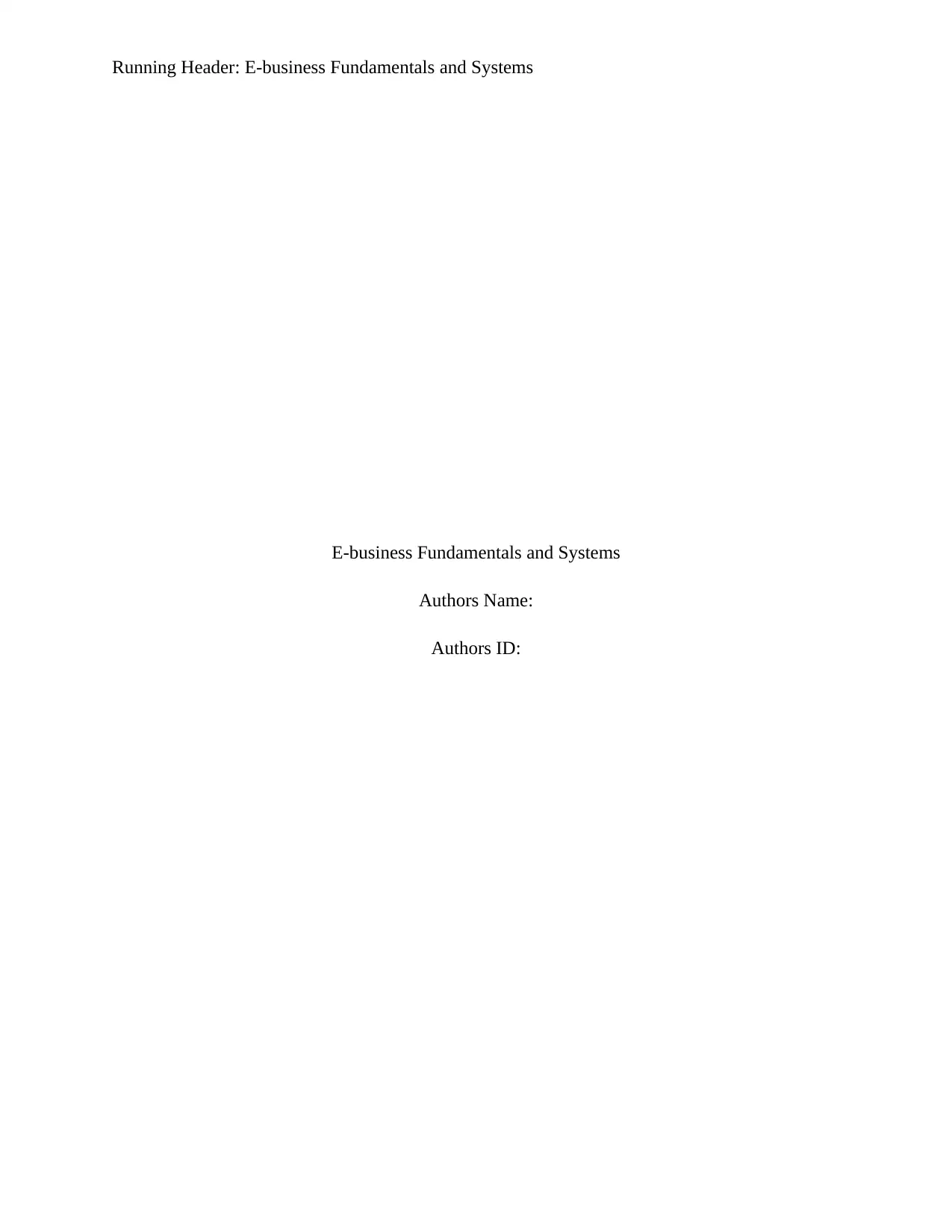
Running Header: E-business Fundamentals and Systems
E-business Fundamentals and Systems
Authors Name:
Authors ID:
E-business Fundamentals and Systems
Authors Name:
Authors ID:
Paraphrase This Document
Need a fresh take? Get an instant paraphrase of this document with our AI Paraphraser
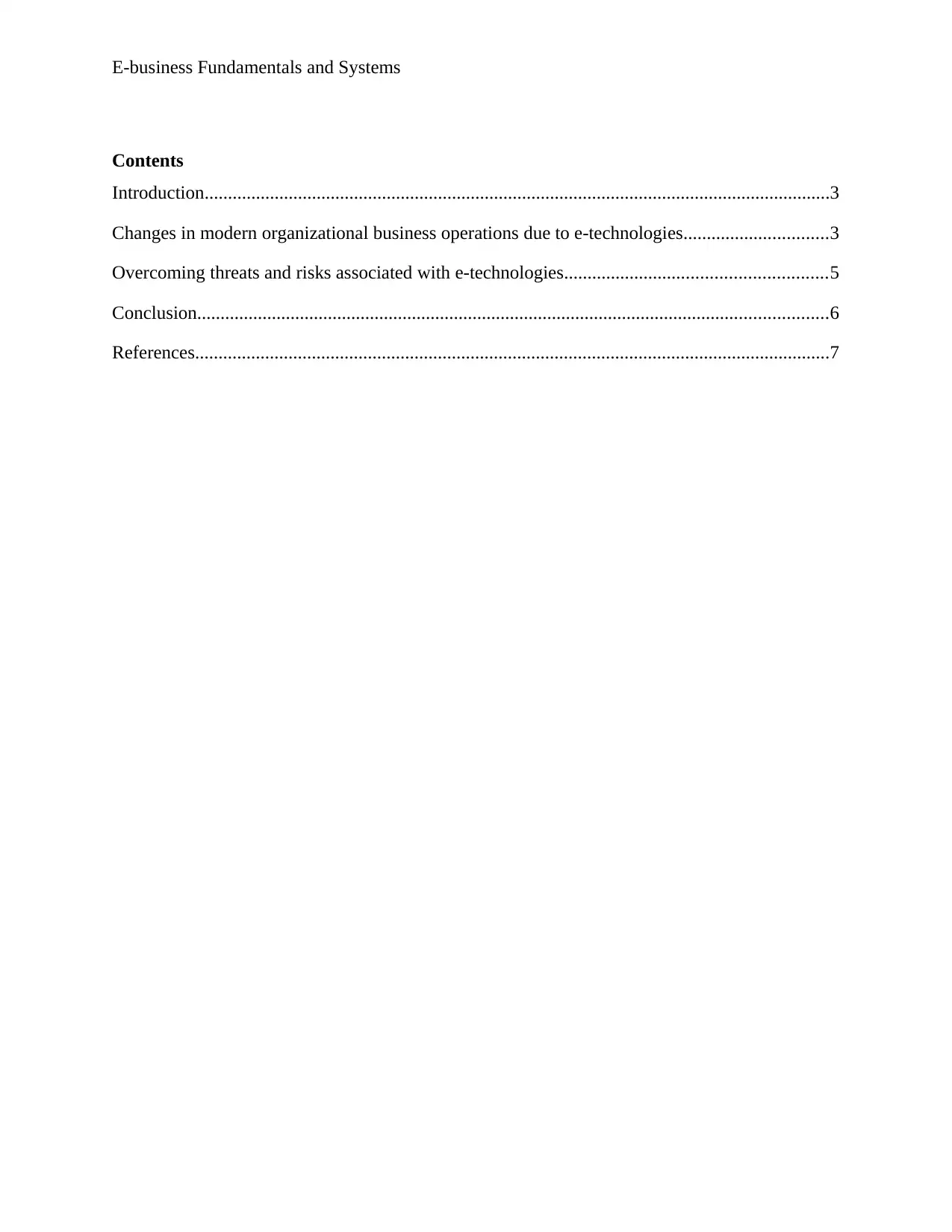
E-business Fundamentals and Systems
Contents
Introduction......................................................................................................................................3
Changes in modern organizational business operations due to e-technologies...............................3
Overcoming threats and risks associated with e-technologies........................................................5
Conclusion.......................................................................................................................................6
References........................................................................................................................................7
Contents
Introduction......................................................................................................................................3
Changes in modern organizational business operations due to e-technologies...............................3
Overcoming threats and risks associated with e-technologies........................................................5
Conclusion.......................................................................................................................................6
References........................................................................................................................................7

E-business Fundamentals and Systems
Introduction
Making use of Web, intranet, internet, extranets or some combinations of some other
contemporary mechanisms for conducting business is referred as the process of electronic
business (E-business). The term e-business has been referred similar to the concept of e-
commerce but one of the biggest difference is that e-business goes beyond the simple process of
buying and selling of products and services through online medium. E-business is a much wide
concept and includes the number of aspects, concepts and business processes such as supply
chain management, customer relationship management and electronic order processing
(Aboelmaged, Mohamed 2015, 606-631). These are some of the business practices that are
required to be executed by the business corporations with greater efficiency and effectiveness.
And e-business aids the business entities in the execution of the processes in a more effective
manner. E-business is a broader concept and encompasses the varied range of other terms such as
e-tailing and e-commerce. As the business corporations are more into digitalization and
modernization the concepts such as enterprise resource planning (ERP), customer relationship
management (CRM) have gained the great level of significance. The below report has been
executed on the concept of e-business technologies and impact of the same on the contemporary
organizational business. Further, the report also comprises of the solutions provided for the
suppliers for the risks and the threats associated with these technologies.
Changes in modern organizational business operations due to e-technologies
The Internet has been considered as one of the greatest and significant element and is also
one of the biggest innovations of e-technologies (Aïmeur, Esma, Umar and Michael 2017). The
Internet has changed the way does the business and the business corporations can take advantage
of the technology for its personal benefits. E-business has been considered as the process of
executing business operations and practices by means of internet and online means and the e-
technologies are the tools e-tools or the medium utilized for the operating business. The process
of e-business encompasses various practices such as exchanging data or information, placing and
taking orders, internal communication (interacting with the staff members) etc. The e-business
technologies are held liable for stimulating the organizational operations in positive and negative
Introduction
Making use of Web, intranet, internet, extranets or some combinations of some other
contemporary mechanisms for conducting business is referred as the process of electronic
business (E-business). The term e-business has been referred similar to the concept of e-
commerce but one of the biggest difference is that e-business goes beyond the simple process of
buying and selling of products and services through online medium. E-business is a much wide
concept and includes the number of aspects, concepts and business processes such as supply
chain management, customer relationship management and electronic order processing
(Aboelmaged, Mohamed 2015, 606-631). These are some of the business practices that are
required to be executed by the business corporations with greater efficiency and effectiveness.
And e-business aids the business entities in the execution of the processes in a more effective
manner. E-business is a broader concept and encompasses the varied range of other terms such as
e-tailing and e-commerce. As the business corporations are more into digitalization and
modernization the concepts such as enterprise resource planning (ERP), customer relationship
management (CRM) have gained the great level of significance. The below report has been
executed on the concept of e-business technologies and impact of the same on the contemporary
organizational business. Further, the report also comprises of the solutions provided for the
suppliers for the risks and the threats associated with these technologies.
Changes in modern organizational business operations due to e-technologies
The Internet has been considered as one of the greatest and significant element and is also
one of the biggest innovations of e-technologies (Aïmeur, Esma, Umar and Michael 2017). The
Internet has changed the way does the business and the business corporations can take advantage
of the technology for its personal benefits. E-business has been considered as the process of
executing business operations and practices by means of internet and online means and the e-
technologies are the tools e-tools or the medium utilized for the operating business. The process
of e-business encompasses various practices such as exchanging data or information, placing and
taking orders, internal communication (interacting with the staff members) etc. The e-business
technologies are held liable for stimulating the organizational operations in positive and negative
⊘ This is a preview!⊘
Do you want full access?
Subscribe today to unlock all pages.

Trusted by 1+ million students worldwide
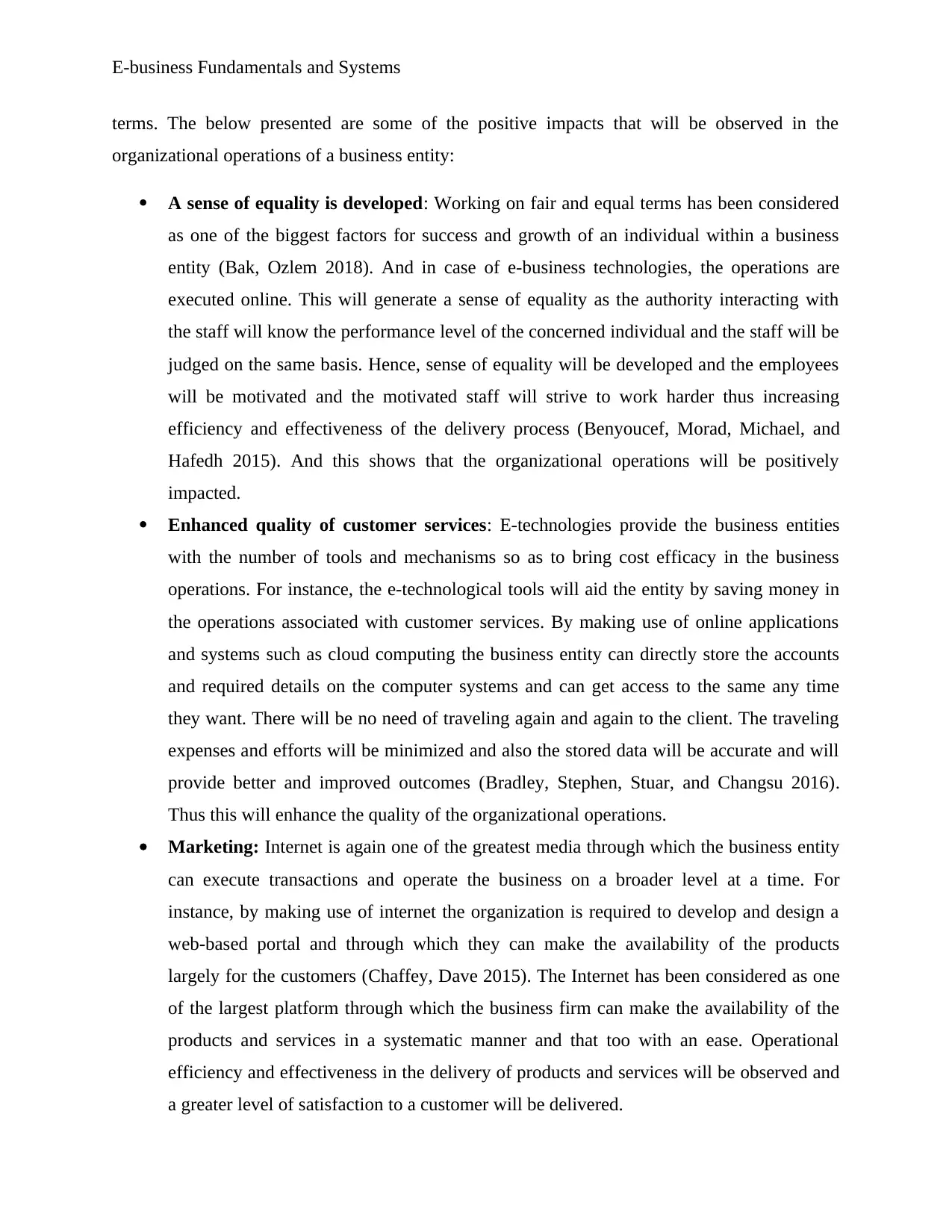
E-business Fundamentals and Systems
terms. The below presented are some of the positive impacts that will be observed in the
organizational operations of a business entity:
A sense of equality is developed: Working on fair and equal terms has been considered
as one of the biggest factors for success and growth of an individual within a business
entity (Bak, Ozlem 2018). And in case of e-business technologies, the operations are
executed online. This will generate a sense of equality as the authority interacting with
the staff will know the performance level of the concerned individual and the staff will be
judged on the same basis. Hence, sense of equality will be developed and the employees
will be motivated and the motivated staff will strive to work harder thus increasing
efficiency and effectiveness of the delivery process (Benyoucef, Morad, Michael, and
Hafedh 2015). And this shows that the organizational operations will be positively
impacted.
Enhanced quality of customer services: E-technologies provide the business entities
with the number of tools and mechanisms so as to bring cost efficacy in the business
operations. For instance, the e-technological tools will aid the entity by saving money in
the operations associated with customer services. By making use of online applications
and systems such as cloud computing the business entity can directly store the accounts
and required details on the computer systems and can get access to the same any time
they want. There will be no need of traveling again and again to the client. The traveling
expenses and efforts will be minimized and also the stored data will be accurate and will
provide better and improved outcomes (Bradley, Stephen, Stuar, and Changsu 2016).
Thus this will enhance the quality of the organizational operations.
Marketing: Internet is again one of the greatest media through which the business entity
can execute transactions and operate the business on a broader level at a time. For
instance, by making use of internet the organization is required to develop and design a
web-based portal and through which they can make the availability of the products
largely for the customers (Chaffey, Dave 2015). The Internet has been considered as one
of the largest platform through which the business firm can make the availability of the
products and services in a systematic manner and that too with an ease. Operational
efficiency and effectiveness in the delivery of products and services will be observed and
a greater level of satisfaction to a customer will be delivered.
terms. The below presented are some of the positive impacts that will be observed in the
organizational operations of a business entity:
A sense of equality is developed: Working on fair and equal terms has been considered
as one of the biggest factors for success and growth of an individual within a business
entity (Bak, Ozlem 2018). And in case of e-business technologies, the operations are
executed online. This will generate a sense of equality as the authority interacting with
the staff will know the performance level of the concerned individual and the staff will be
judged on the same basis. Hence, sense of equality will be developed and the employees
will be motivated and the motivated staff will strive to work harder thus increasing
efficiency and effectiveness of the delivery process (Benyoucef, Morad, Michael, and
Hafedh 2015). And this shows that the organizational operations will be positively
impacted.
Enhanced quality of customer services: E-technologies provide the business entities
with the number of tools and mechanisms so as to bring cost efficacy in the business
operations. For instance, the e-technological tools will aid the entity by saving money in
the operations associated with customer services. By making use of online applications
and systems such as cloud computing the business entity can directly store the accounts
and required details on the computer systems and can get access to the same any time
they want. There will be no need of traveling again and again to the client. The traveling
expenses and efforts will be minimized and also the stored data will be accurate and will
provide better and improved outcomes (Bradley, Stephen, Stuar, and Changsu 2016).
Thus this will enhance the quality of the organizational operations.
Marketing: Internet is again one of the greatest media through which the business entity
can execute transactions and operate the business on a broader level at a time. For
instance, by making use of internet the organization is required to develop and design a
web-based portal and through which they can make the availability of the products
largely for the customers (Chaffey, Dave 2015). The Internet has been considered as one
of the largest platform through which the business firm can make the availability of the
products and services in a systematic manner and that too with an ease. Operational
efficiency and effectiveness in the delivery of products and services will be observed and
a greater level of satisfaction to a customer will be delivered.
Paraphrase This Document
Need a fresh take? Get an instant paraphrase of this document with our AI Paraphraser
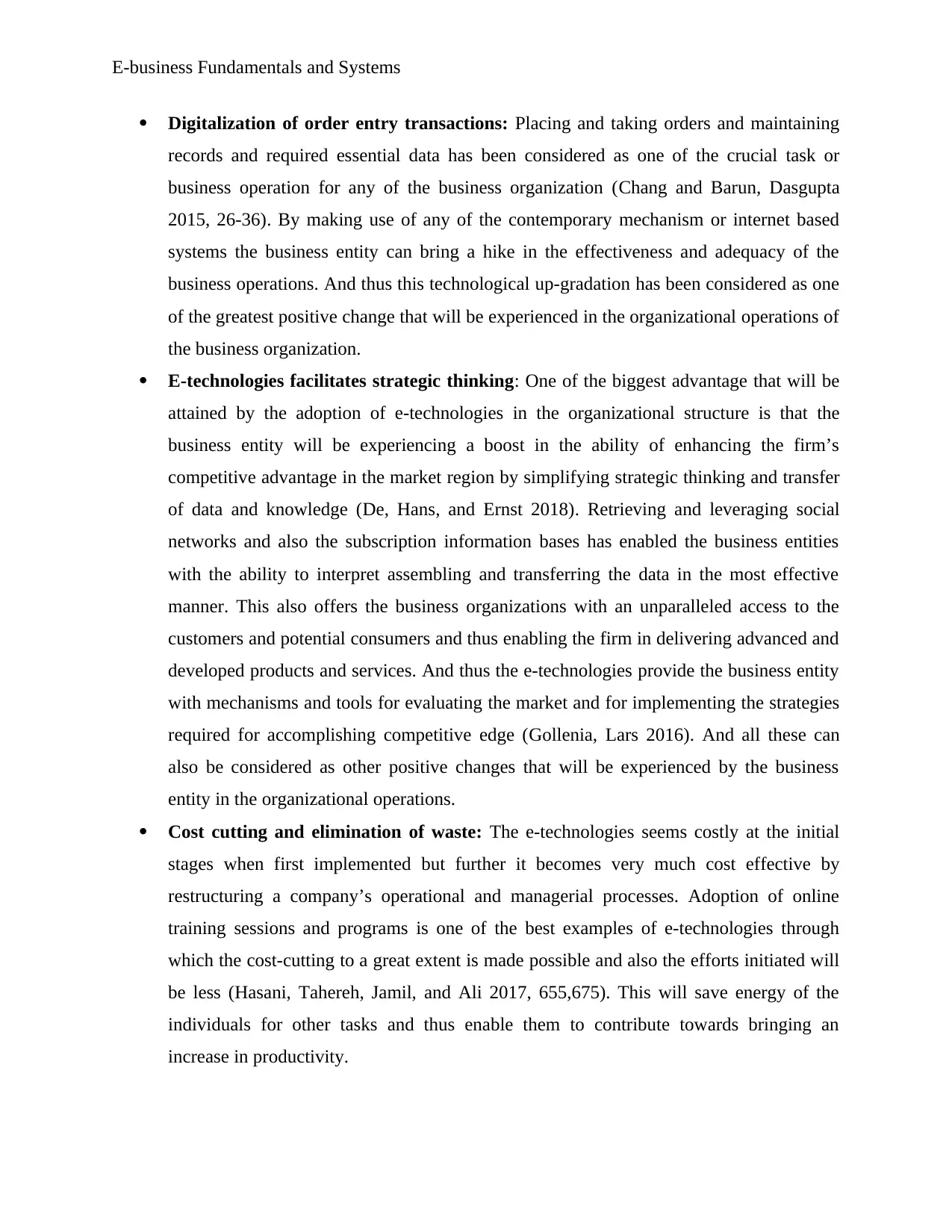
E-business Fundamentals and Systems
Digitalization of order entry transactions: Placing and taking orders and maintaining
records and required essential data has been considered as one of the crucial task or
business operation for any of the business organization (Chang and Barun, Dasgupta
2015, 26-36). By making use of any of the contemporary mechanism or internet based
systems the business entity can bring a hike in the effectiveness and adequacy of the
business operations. And thus this technological up-gradation has been considered as one
of the greatest positive change that will be experienced in the organizational operations of
the business organization.
E-technologies facilitates strategic thinking: One of the biggest advantage that will be
attained by the adoption of e-technologies in the organizational structure is that the
business entity will be experiencing a boost in the ability of enhancing the firm’s
competitive advantage in the market region by simplifying strategic thinking and transfer
of data and knowledge (De, Hans, and Ernst 2018). Retrieving and leveraging social
networks and also the subscription information bases has enabled the business entities
with the ability to interpret assembling and transferring the data in the most effective
manner. This also offers the business organizations with an unparalleled access to the
customers and potential consumers and thus enabling the firm in delivering advanced and
developed products and services. And thus the e-technologies provide the business entity
with mechanisms and tools for evaluating the market and for implementing the strategies
required for accomplishing competitive edge (Gollenia, Lars 2016). And all these can
also be considered as other positive changes that will be experienced by the business
entity in the organizational operations.
Cost cutting and elimination of waste: The e-technologies seems costly at the initial
stages when first implemented but further it becomes very much cost effective by
restructuring a company’s operational and managerial processes. Adoption of online
training sessions and programs is one of the best examples of e-technologies through
which the cost-cutting to a great extent is made possible and also the efforts initiated will
be less (Hasani, Tahereh, Jamil, and Ali 2017, 655,675). This will save energy of the
individuals for other tasks and thus enable them to contribute towards bringing an
increase in productivity.
Digitalization of order entry transactions: Placing and taking orders and maintaining
records and required essential data has been considered as one of the crucial task or
business operation for any of the business organization (Chang and Barun, Dasgupta
2015, 26-36). By making use of any of the contemporary mechanism or internet based
systems the business entity can bring a hike in the effectiveness and adequacy of the
business operations. And thus this technological up-gradation has been considered as one
of the greatest positive change that will be experienced in the organizational operations of
the business organization.
E-technologies facilitates strategic thinking: One of the biggest advantage that will be
attained by the adoption of e-technologies in the organizational structure is that the
business entity will be experiencing a boost in the ability of enhancing the firm’s
competitive advantage in the market region by simplifying strategic thinking and transfer
of data and knowledge (De, Hans, and Ernst 2018). Retrieving and leveraging social
networks and also the subscription information bases has enabled the business entities
with the ability to interpret assembling and transferring the data in the most effective
manner. This also offers the business organizations with an unparalleled access to the
customers and potential consumers and thus enabling the firm in delivering advanced and
developed products and services. And thus the e-technologies provide the business entity
with mechanisms and tools for evaluating the market and for implementing the strategies
required for accomplishing competitive edge (Gollenia, Lars 2016). And all these can
also be considered as other positive changes that will be experienced by the business
entity in the organizational operations.
Cost cutting and elimination of waste: The e-technologies seems costly at the initial
stages when first implemented but further it becomes very much cost effective by
restructuring a company’s operational and managerial processes. Adoption of online
training sessions and programs is one of the best examples of e-technologies through
which the cost-cutting to a great extent is made possible and also the efforts initiated will
be less (Hasani, Tahereh, Jamil, and Ali 2017, 655,675). This will save energy of the
individuals for other tasks and thus enable them to contribute towards bringing an
increase in productivity.

E-business Fundamentals and Systems
Overcoming threats and risks associated with e-technologies
Threats and risk to e-technologies are an everyday reality for most of the business corporations.
These threats and risks are problematic situations that are required to be handled efficiently by
the technology suppliers (Kadry, Seifedine, and Abdelkhalak 2017). The below presented are the
practical implications that are required to be adhered by the technology suppliers for tackling and
dealing with the associated threats and risks:
Securing computer and other wireless systems
Use of anti-spyware, anti-virus and firewalls for protecting the systems
Regular and timely up-gradation of software systems
Creating data back-ups
Maintaining and securing passwords
Training to the concerned staff should be provided (Monfort, Valérie and Karl-Heinz
Krempels, 2015).
Making them understand the legal norms and regulations
There are more specific preventions that can be adopted by the suppliers of e-technology and the
same is presented below:
Developing a secure online presence:
The online presence of a business entity has been considered as one of the supporting pillar in
success and growth. And hence is one of the integral operations for any of the firm. Online
presence is the brand equity of an enterprise in the digital world and hence is required to be
secured and prevented from threats and risks (Tsuma, Victor, and Mark 2017, 164-176). Under
this system, the business entity is required to assess the security of the web-based portals,
websites, email accounts, online stored data and online banking accounts. There is the number of
systems and applications that can be adopted by the technology suppliers for preventing the
online presence of the enterprise. For instance, secure socket layer (SSL), is one of the
technologies that can be installed for encrypting transactional data and for sending customer and
card details to the bank that is the acquiring authority for authorization. Moreover, it should also
be ensured that any web-hosting solution considered should be capable of supporting the SSL
protocol.
Overcoming threats and risks associated with e-technologies
Threats and risk to e-technologies are an everyday reality for most of the business corporations.
These threats and risks are problematic situations that are required to be handled efficiently by
the technology suppliers (Kadry, Seifedine, and Abdelkhalak 2017). The below presented are the
practical implications that are required to be adhered by the technology suppliers for tackling and
dealing with the associated threats and risks:
Securing computer and other wireless systems
Use of anti-spyware, anti-virus and firewalls for protecting the systems
Regular and timely up-gradation of software systems
Creating data back-ups
Maintaining and securing passwords
Training to the concerned staff should be provided (Monfort, Valérie and Karl-Heinz
Krempels, 2015).
Making them understand the legal norms and regulations
There are more specific preventions that can be adopted by the suppliers of e-technology and the
same is presented below:
Developing a secure online presence:
The online presence of a business entity has been considered as one of the supporting pillar in
success and growth. And hence is one of the integral operations for any of the firm. Online
presence is the brand equity of an enterprise in the digital world and hence is required to be
secured and prevented from threats and risks (Tsuma, Victor, and Mark 2017, 164-176). Under
this system, the business entity is required to assess the security of the web-based portals,
websites, email accounts, online stored data and online banking accounts. There is the number of
systems and applications that can be adopted by the technology suppliers for preventing the
online presence of the enterprise. For instance, secure socket layer (SSL), is one of the
technologies that can be installed for encrypting transactional data and for sending customer and
card details to the bank that is the acquiring authority for authorization. Moreover, it should also
be ensured that any web-hosting solution considered should be capable of supporting the SSL
protocol.
⊘ This is a preview!⊘
Do you want full access?
Subscribe today to unlock all pages.

Trusted by 1+ million students worldwide

E-business Fundamentals and Systems
Induction programs and IT training for staff: Providing training sessions to the new staff
regarding the It policies, procedures and regulations that are pursued within the business
organization and this operation has been considered as one of the significant steps of the risk
management strategies (Turban et al. 2015). These types of training sessions will cover the key
business operations such as:
Safe handling of infected emails and systems
Maintaining and preventing the privacy of customer details
Priority actions in an occurrence of an online security breach
The supplier or the training head have some legal obligations while providing training to the
staff (Veit et al. 2014, 45-53).
Business insurance: It is not possible for a business entity and for a technology supplier to
prevent or eliminate IT risks and threats. And hence ensuring the business has been considered as
a crucial and integral task in the concept of securing the e-business from threats and risks and
recovery planning (Zurawski, Richard 2016). There is the varied range of operations that are
required to be executed for ensuring the firm such as regularly updating the insurance, especially
in relation to the new or emerging risks and threats to the business. Such as excessive use of
mobile personal cell phones for workplace practices.
Conclusion
In the limelight of the above-executed analysis, it has been concluded that e-business has been
considered as one of the contemporary forms of executing business practices. In this form of
business, the concept of e-technologies plays an integral role in operating the business in the
present era. The above-presented report has been segmented majorly into two sections and from
which the first part is concerned about the changes or the alterations that have been introduced
by the emergence of the concept of e-technologies in the organizational operations. The second
part is focused on the threats and the risks associated with the operations and also the solutions
are provided for the technological suppliers in order to deal and tackle these issues.
Induction programs and IT training for staff: Providing training sessions to the new staff
regarding the It policies, procedures and regulations that are pursued within the business
organization and this operation has been considered as one of the significant steps of the risk
management strategies (Turban et al. 2015). These types of training sessions will cover the key
business operations such as:
Safe handling of infected emails and systems
Maintaining and preventing the privacy of customer details
Priority actions in an occurrence of an online security breach
The supplier or the training head have some legal obligations while providing training to the
staff (Veit et al. 2014, 45-53).
Business insurance: It is not possible for a business entity and for a technology supplier to
prevent or eliminate IT risks and threats. And hence ensuring the business has been considered as
a crucial and integral task in the concept of securing the e-business from threats and risks and
recovery planning (Zurawski, Richard 2016). There is the varied range of operations that are
required to be executed for ensuring the firm such as regularly updating the insurance, especially
in relation to the new or emerging risks and threats to the business. Such as excessive use of
mobile personal cell phones for workplace practices.
Conclusion
In the limelight of the above-executed analysis, it has been concluded that e-business has been
considered as one of the contemporary forms of executing business practices. In this form of
business, the concept of e-technologies plays an integral role in operating the business in the
present era. The above-presented report has been segmented majorly into two sections and from
which the first part is concerned about the changes or the alterations that have been introduced
by the emergence of the concept of e-technologies in the organizational operations. The second
part is focused on the threats and the risks associated with the operations and also the solutions
are provided for the technological suppliers in order to deal and tackle these issues.
Paraphrase This Document
Need a fresh take? Get an instant paraphrase of this document with our AI Paraphraser
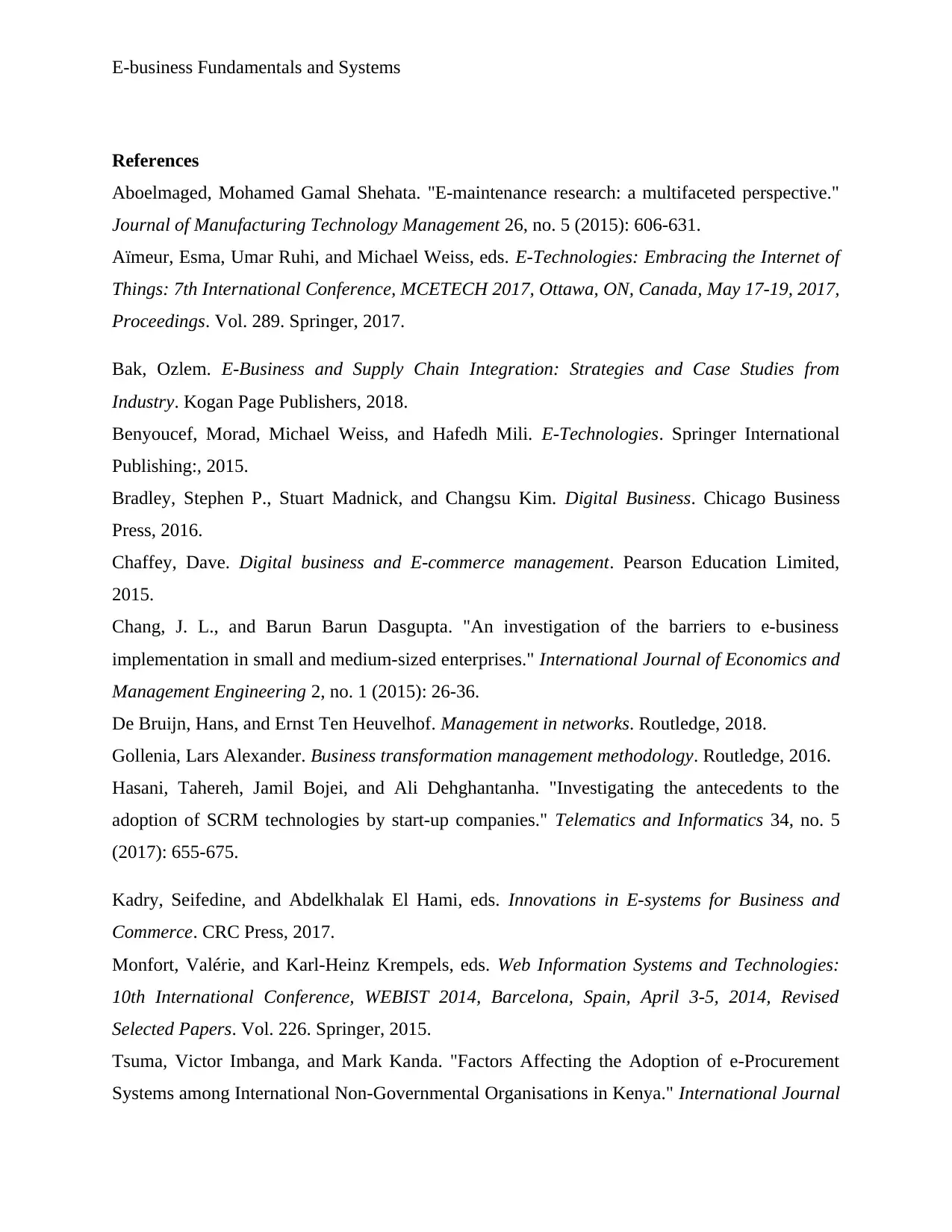
E-business Fundamentals and Systems
References
Aboelmaged, Mohamed Gamal Shehata. "E-maintenance research: a multifaceted perspective."
Journal of Manufacturing Technology Management 26, no. 5 (2015): 606-631.
Aïmeur, Esma, Umar Ruhi, and Michael Weiss, eds. E-Technologies: Embracing the Internet of
Things: 7th International Conference, MCETECH 2017, Ottawa, ON, Canada, May 17-19, 2017,
Proceedings. Vol. 289. Springer, 2017.
Bak, Ozlem. E-Business and Supply Chain Integration: Strategies and Case Studies from
Industry. Kogan Page Publishers, 2018.
Benyoucef, Morad, Michael Weiss, and Hafedh Mili. E-Technologies. Springer International
Publishing:, 2015.
Bradley, Stephen P., Stuart Madnick, and Changsu Kim. Digital Business. Chicago Business
Press, 2016.
Chaffey, Dave. Digital business and E-commerce management. Pearson Education Limited,
2015.
Chang, J. L., and Barun Barun Dasgupta. "An investigation of the barriers to e-business
implementation in small and medium-sized enterprises." International Journal of Economics and
Management Engineering 2, no. 1 (2015): 26-36.
De Bruijn, Hans, and Ernst Ten Heuvelhof. Management in networks. Routledge, 2018.
Gollenia, Lars Alexander. Business transformation management methodology. Routledge, 2016.
Hasani, Tahereh, Jamil Bojei, and Ali Dehghantanha. "Investigating the antecedents to the
adoption of SCRM technologies by start-up companies." Telematics and Informatics 34, no. 5
(2017): 655-675.
Kadry, Seifedine, and Abdelkhalak El Hami, eds. Innovations in E-systems for Business and
Commerce. CRC Press, 2017.
Monfort, Valérie, and Karl-Heinz Krempels, eds. Web Information Systems and Technologies:
10th International Conference, WEBIST 2014, Barcelona, Spain, April 3-5, 2014, Revised
Selected Papers. Vol. 226. Springer, 2015.
Tsuma, Victor Imbanga, and Mark Kanda. "Factors Affecting the Adoption of e-Procurement
Systems among International Non-Governmental Organisations in Kenya." International Journal
References
Aboelmaged, Mohamed Gamal Shehata. "E-maintenance research: a multifaceted perspective."
Journal of Manufacturing Technology Management 26, no. 5 (2015): 606-631.
Aïmeur, Esma, Umar Ruhi, and Michael Weiss, eds. E-Technologies: Embracing the Internet of
Things: 7th International Conference, MCETECH 2017, Ottawa, ON, Canada, May 17-19, 2017,
Proceedings. Vol. 289. Springer, 2017.
Bak, Ozlem. E-Business and Supply Chain Integration: Strategies and Case Studies from
Industry. Kogan Page Publishers, 2018.
Benyoucef, Morad, Michael Weiss, and Hafedh Mili. E-Technologies. Springer International
Publishing:, 2015.
Bradley, Stephen P., Stuart Madnick, and Changsu Kim. Digital Business. Chicago Business
Press, 2016.
Chaffey, Dave. Digital business and E-commerce management. Pearson Education Limited,
2015.
Chang, J. L., and Barun Barun Dasgupta. "An investigation of the barriers to e-business
implementation in small and medium-sized enterprises." International Journal of Economics and
Management Engineering 2, no. 1 (2015): 26-36.
De Bruijn, Hans, and Ernst Ten Heuvelhof. Management in networks. Routledge, 2018.
Gollenia, Lars Alexander. Business transformation management methodology. Routledge, 2016.
Hasani, Tahereh, Jamil Bojei, and Ali Dehghantanha. "Investigating the antecedents to the
adoption of SCRM technologies by start-up companies." Telematics and Informatics 34, no. 5
(2017): 655-675.
Kadry, Seifedine, and Abdelkhalak El Hami, eds. Innovations in E-systems for Business and
Commerce. CRC Press, 2017.
Monfort, Valérie, and Karl-Heinz Krempels, eds. Web Information Systems and Technologies:
10th International Conference, WEBIST 2014, Barcelona, Spain, April 3-5, 2014, Revised
Selected Papers. Vol. 226. Springer, 2015.
Tsuma, Victor Imbanga, and Mark Kanda. "Factors Affecting the Adoption of e-Procurement
Systems among International Non-Governmental Organisations in Kenya." International Journal
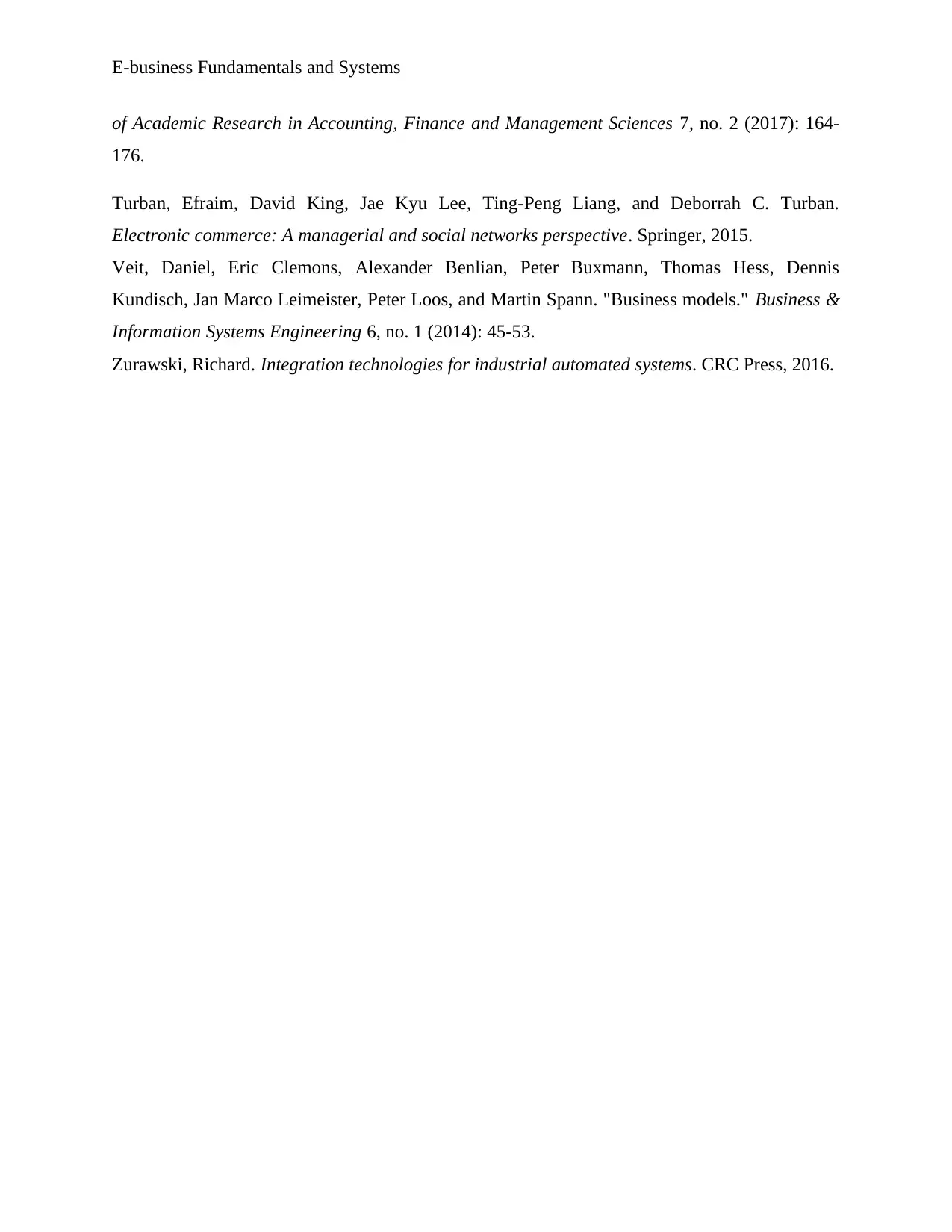
E-business Fundamentals and Systems
of Academic Research in Accounting, Finance and Management Sciences 7, no. 2 (2017): 164-
176.
Turban, Efraim, David King, Jae Kyu Lee, Ting-Peng Liang, and Deborrah C. Turban.
Electronic commerce: A managerial and social networks perspective. Springer, 2015.
Veit, Daniel, Eric Clemons, Alexander Benlian, Peter Buxmann, Thomas Hess, Dennis
Kundisch, Jan Marco Leimeister, Peter Loos, and Martin Spann. "Business models." Business &
Information Systems Engineering 6, no. 1 (2014): 45-53.
Zurawski, Richard. Integration technologies for industrial automated systems. CRC Press, 2016.
of Academic Research in Accounting, Finance and Management Sciences 7, no. 2 (2017): 164-
176.
Turban, Efraim, David King, Jae Kyu Lee, Ting-Peng Liang, and Deborrah C. Turban.
Electronic commerce: A managerial and social networks perspective. Springer, 2015.
Veit, Daniel, Eric Clemons, Alexander Benlian, Peter Buxmann, Thomas Hess, Dennis
Kundisch, Jan Marco Leimeister, Peter Loos, and Martin Spann. "Business models." Business &
Information Systems Engineering 6, no. 1 (2014): 45-53.
Zurawski, Richard. Integration technologies for industrial automated systems. CRC Press, 2016.
⊘ This is a preview!⊘
Do you want full access?
Subscribe today to unlock all pages.

Trusted by 1+ million students worldwide
1 out of 9
Related Documents
Your All-in-One AI-Powered Toolkit for Academic Success.
+13062052269
info@desklib.com
Available 24*7 on WhatsApp / Email
![[object Object]](/_next/static/media/star-bottom.7253800d.svg)
Unlock your academic potential
Copyright © 2020–2025 A2Z Services. All Rights Reserved. Developed and managed by ZUCOL.




